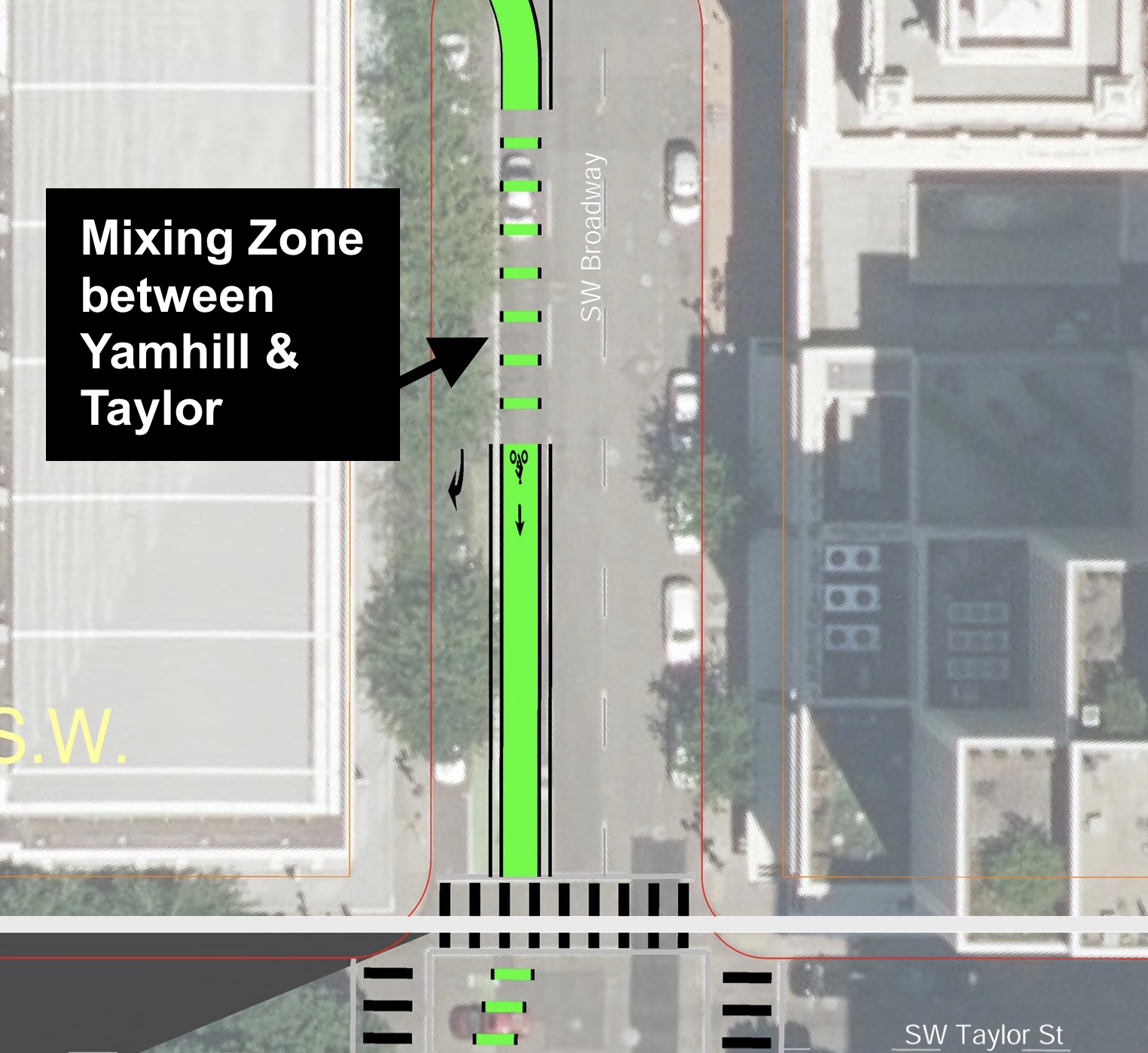
By the end of this year there will be a protected bike lane through Portland’s “Living Room.”

Starting in June, the transportation bureau will begin to build a protected bike lane on Southwest Broadway between Oak and Clay. Broadway is our city’s marquee main street that runs adjacent to Pioneer Courthouse Square (a.k.a. Portland’s Living Room) and through a shopping, cultural, and university district. The project will fill a gap in existing protected bike lanes to the north and south and fulfill a promise of safe cycling access that began 13 years ago with Portland’s first cycle track on Broadway near Portland State University and that we got a glimpse of in 2016 when a group of planners tested a pop-up version of the city’s design in 2016.
On April 11th, the Portland Bureau of Transportation shared newly updated plans (PDF) at a meeting of their Central City in Motion (CCIM) working group. CCIM is a plan adopted by Portland City Council in 2018 that aims to build 18 projects to boost biking, walking and transit rates downtown and in the central eastside.
The plan for Broadway is to continue a parking-protected bike lane design similar to the one already in place on both ends of this project.
PBOT wants to swap locations of the existing bike lane and curbside parking lane on the one-way street. In doing so, they will add width and protection to the bike lane, a move that will reduce space for driving. The current cross-section includes six lanes; two parking lanes, three traffic lanes and one unprotected, narrow, door-zone, bike-only lane. The new cross-section will include five lanes; two for traffic, two for parking cars and one only for bicycle (and micromobility vehicle) users. In some locations, the space for driving will be even smaller: The block between SW Harvey Milk and Oak will be striped with a northbound (contraflow) bike lane which will eliminate space previously used to park cars; and driving space will also be lost at Yamhill and Morrison where curb extensions narrow the intersection width.
Advertisement


As is the rule in cities, when we reduce space for cars, everything else works much better. This project will vastly improve Broadway for walkers and other non-driving road users. People will not only have effectively narrower and safer streets to walk across, they’ll also see big upgrades to crosswalks in the form of more striping (what PBOT calls “high visibility crosswalks”) and fewer car parking spaces near intersections.
As with any bikeway project, the key to its success will be where car users are allowed to cross over it. On Broadway, beyond typical concerns with right-hooks at intersections, a few other issues pop out: There are two major hotels along the project route and there’s a mixing zone planned between Yamhill and Taylor.
On the block between Yamhill and Taylor, PBOT will allow another incursion into the bike lane. Instead of requiring people to turn right at the intersection with Taylor, PBOT has designed a break in the bike lane where car and bike lane users will cross over each other so drivers can make the right turn onto Taylor from a curbside lane. When a CCIM committee member expressed concerns about this design at the April 11th meeting, PBOT project manager Brianna Orr said a combination of outdated signal equipment (that doesn’t allow for a separate bike signal phase) and a high turning volume led to this design choice. PBOT is expected to upgrade the signal in a later phase of the project, but funding has not yet been identified.
Advertisement
“It’s a shame when a facility is an ‘all ages and ability route’ except for one block,” one working group member expressed at the meeting. PBOT’s Orr said there’s still time to consult with engineers and look for other solutions.
Another notable part of the proposed design is the new contraflow bike lane between SW Harvey Milk and Oak where bicycle users will have a left turn lane from eastbound Harvey Milk onto northbound Broadway, where they’ll ride against oncoming lanes of car traffic.
We also see how PBOT has addressed a busy driving into a parking garage just south of Harvey Milk. In order to slow down drivers as they enter the driveway, PBOT plans to install three rubberized, turn-calming curbs to create a 90-degree entry angle (this slows drivers down and encourages better visibility of bike lane traffic).
Another area where PBOT will beef up the bikeway is at the intersection with SW Jefferson where another important bikeway route crosses Broadway. The plan for the northwest corner of Broadway and Jefferson is a mini protected intersection that will utilize rubber curbs and generous use of green pavement coloring to manage traffic flows.
PBOT says construction on this $500,000 “quick build” project is set for June of this year. Once complete, Broadway will form a bikeway couplet with SW 4th, a more substantial capital project PBOT says they plan to break ground on this fall.
UPDATE/CORRECTION, 4/20 at 12:55 pm: This post initially stated that PBOT would maintain three parking spaces curbside in the bike lane near two major hotels for loading and unloading of passengers. That was based on notes from a recent CCIM working group meeting that mentioned a “shared curbside” and a need to “minimize conflicts.” PBOT’s Dylan Rivera has just emailed to clarify that, “Parking spaces will not be curbside. They will be to the east of the bike lane, as shown in Before/After image… Vehicle parking will not be allowed in the bike lane. People will be able to walk across the bike lane to access their parked cars, going to or from the hotels or other destinations.”
We regret the confusion.


